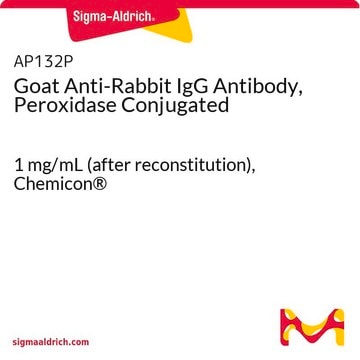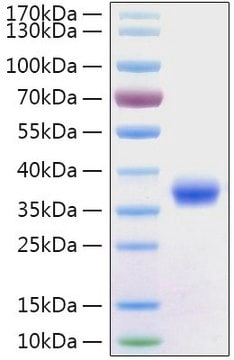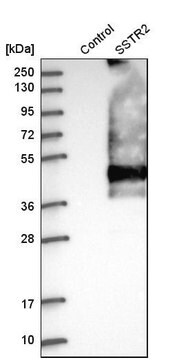AP132B
Goat Anti-Rabbit IgG Antibody, biotin-SP conjugate
Chemicon®, from goat
About This Item
Recommended Products
biological source
goat
Quality Level
conjugate
biotin conjugate
antibody form
affinity purified immunoglobulin
antibody product type
secondary antibodies
clone
polyclonal
species reactivity
rabbit
manufacturer/tradename
Chemicon®
technique(s)
ELISA: suitable
western blot: suitable
shipped in
wet ice
target post-translational modification
unmodified
General description
Application
Western blots using enzyme-conjugated streptavidin: 1:10,000-1:100,000.
Immunohistochemistry: 1:500-1:5,000
Flow cytometry: 1:200-1:1,000
Fluorescence Immunohisto/cytochemistry: 1:200-1:1,000
Optimal working dilutions must be determined by end user.
Secondary & Control Antibodies
Whole Immunoglobulin Secondary Antibodies
Physical form
Reconstitute with sterile distilled water to match the volume indicated on the vial label.
Storage and Stability
WARNING:
For research use only; not for use as a diagnostic.
Legal Information
Disclaimer
Not finding the right product?
Try our Product Selector Tool.
Signal Word
Warning
Hazard Statements
Precautionary Statements
Hazard Classifications
Acute Tox. 4 Dermal - Acute Tox. 4 Inhalation - Acute Tox. 4 Oral - Aquatic Chronic 3
Storage Class Code
13 - Non Combustible Solids
WGK
WGK 3
Flash Point(F)
Not applicable
Flash Point(C)
Not applicable
Certificates of Analysis (COA)
Search for Certificates of Analysis (COA) by entering the products Lot/Batch Number. Lot and Batch Numbers can be found on a product’s label following the words ‘Lot’ or ‘Batch’.
Already Own This Product?
Find documentation for the products that you have recently purchased in the Document Library.
Our team of scientists has experience in all areas of research including Life Science, Material Science, Chemical Synthesis, Chromatography, Analytical and many others.
Contact Technical Service









